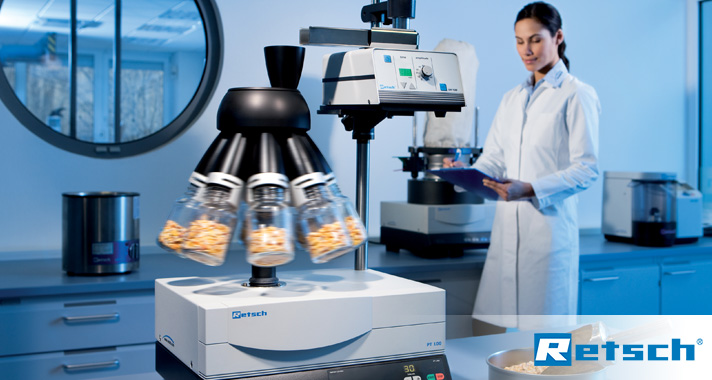In RETSCH ́s Rotating Sample Divider PT 100, the sample is fed into the hopper and automatically transported via a feed chute to the openings of an evenly rotating dividing head.
Modern analytical methods increase precision and push detection limits to make even the smallest traces of sample components detectable. Despite this development sample preparation, which is carried out prior to the actual analysis, is frequently neglected.
Minimize standard deviations
Errors caused by lacking accuracy in sample preparation have a much bigger impact than errors made during analysis. Just like an iceberg which is mostly hidden under water, only a small part of the sum of errors is perceived whereas the major part of potential errors is not taken into account. One of the reasons may be the fact that sampling and sample preparation have always been done in a traditional way which has become a routine over the years and is no longer considered as having a critical influence on the subsequent analyses.
Sampling
The more heterogeneous a sample is the more important correct sample preparation becomes. Before a sample is taken from a sand heap, for example, several questions have to be answered.
- Which is the correct sample amount so that all sample properties of the original lot are represented?
- Does it have any influence from which area of the heap the sample is taken?
- Did the sample segregate so that bigger particles are mostly found in the upper part of the heap?
If the last question is answered with yes, the subsample taken from the upper part of the heap does not represent the initial lot. Also less obvious aspects can have an influence here: if the heap of sand was stored outside, then the material on the surface of the heap contains more moisture than the inside part. This means that the property “moisture” is distributed heterogeneously in the initial material.
Sample Division
The properties of a laboratory sample are usually heterogeneously distributed; milling helps to homogenize the sample and to equally distribute its properties. Only a few grams or milligrams of the laboratory sample are required for the subsequent analysis. Hence, larger subsamples have to be divided representatively. Standardized methods such as coning and quartering or the use of sample splitters or sample dividers help to divide the subsamples, showing that increased automation reduces statistic errors and increases representativeness of the subsample.
Homogenization of samples by grinding
Many laboratory samples cannot be analyzed directly because they contain big or segregated particles. Big particles can be a problem because most analytical methods will not measure all components of the particle but only the surface. The effects of segregation are described above. Grinding those samples helps to reduce the particle size so that the inner parts become available for analysis. Ideally, the properties which are originally spread heterogeneously all over the sample are distributed homogenously after the grinding step. The following examples demonstrate that correct sample preparation is a pre-requisite for minimum standard deviations and increased reproducibility of analytical results.
Download the white paper by Dr Taja Hanke, Retsch Gmbh “How to minimize standard deviations by correct sample preparation” explaining the topic in details with examples.









